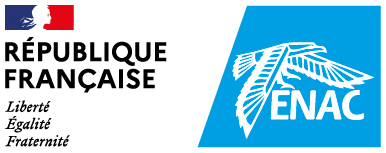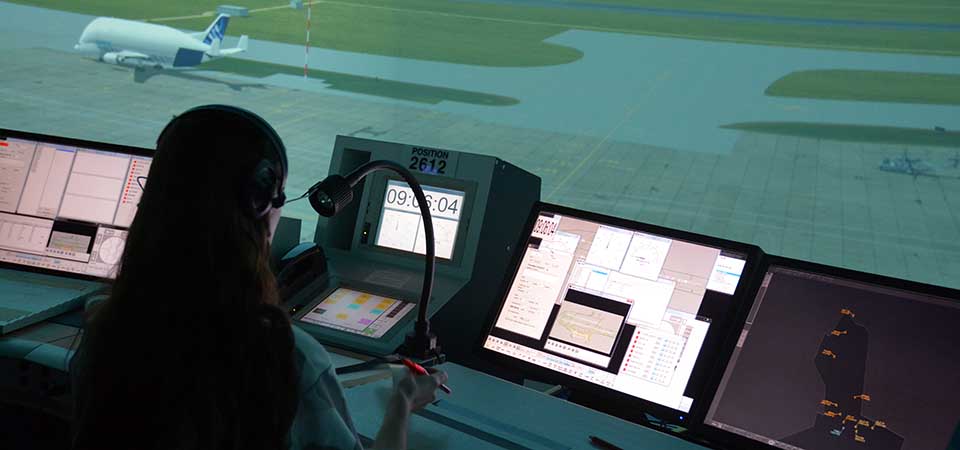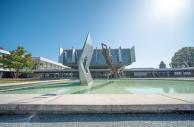About ENAC’s Air Traffic Control Simulators
“ATC Simulators Block”
This building was originally conceived like a true operational center with its operational training space on the first floor and technical maintenance area, space for design and technical use of simulators on the ground floor.
The “ATC Simulators Block” building, regarding its capacity to accommodate its teaching equipment and resources (CBT, Tower, Approach, En Route), has a surface area of 2, 200 square meters. Similarly, the set of facilities for technical maintenance, technical rooms, laboratories and staff offices for technical maintenance, also covers 2,200 square meters.
For CBT (Computer-Based Training), the “ATC Simulators Block” building has four rooms and 66 dual screen positions that offer several methods of training.
For Tower and Approach, the “ATC Simulators Block” possesses the SCANSIM simulation system.
For En-Route training, the “ATC Simulators Block” has two distinct simulation systems: ELECTRA, which was developed from the French operational CAUTRA, and ESCAPE, a stripless (paper-less) simulator from EUROCONTROL Bretigny.
The “ATC Simulator Block” capabilities in a nutshell:
- CBT and Simulations surface area: 2,200 m2
- Technical space and staff offices 2,200 m2
- CBT Rooms: 66 dual-screen positions
- 3-D Tower Simulators:13 operational suites
- Approach Simulators: 10 operational suites
- En Route Simulators: 20 operational suites with a surface area of 900m2
- Operational equipment: 2 900 pieces of operational equipment (1 060 PCs and 83 Servers/990 screens) and
- 190 Audiolan VCS positions (Voice Communication System)
Computer-Based Training (CBT)
ENAC has used CBT for Air Traffic Control practical training for over 20 years. This experience has allowed it to develop tools that are adapted to each phase of training in order to prepare students for simulator-based instruction.
There are 3 distinct training sessions:
- CBT Data Exercises
- The CBT Data are developed using Commercial off the Shelf (COTS) Software. It allows the trainee to experience the working environment (such as aircraft performance),
- CBTDyn Exercises
CBTDynis a software developed by ENAC that makes it possible to produce the simulator environment on a dual screen computer. The student faces ATC situations and must apply the appropriate working method. CBTDYn checks the actions of the student and corrects when necessary. CBTDyn allows practice on multiple aspects of the working method: phraseology, integration of flight data, conflict detection and resolution, strip management in a paper-strip environment - or handling HMI in a stripless environment.
ELSA Exercises
ELSA is a software owned and developed by ENAC. It produces exercises dedicated to the practice of radar vectoring: ILS sequencing, pre-sequencing, and conflict resolution. ELSA checks the clearances sent by the student, performs the relevant read-back and make the situation evolve like a simulator would. Key performance indicators are calculated in real time and given to trainees: compliance with separation minima, landing rate, military area, distance covered by aircraft, fuel consumption, etc...
All of these exercises can be performed either locally on CBT positions made available to students, or remotely via internet and ENAC E-Campus.

Tower and Approach Simulator
SCANSIM is an Air Traffic Control Simulation software used at ENAC for Tower and Approach control phases. Initially created by ENAC, it is now produced industrially by SIMULAVIA.
As an integrated simulator, it allows instructors to design environments, exercises, as well as HMI for pilots and controllers. With multiple positions and multiple sectors, it works on a Windows PC network.
It can be connected with tools installed in operational control centers, tools like IRMA (a radar visualization of aerial movement), like SPIP (a server used for maps display, MSAW (Minimum Safe Altitude Warning), APW (Area proximity warning) and safety net) or like AMAN/DMAN (Arrival/Departure Manager).
SCANSIM has 4 versions: E-TOWER, SCANTOWER, SCANBana and SCANRAD
E-TOWER is installed in two stalls, the two new e-TWR simulators offer the flexibility of generic electronic stripping or paper stripping. With their immersive 86-inch, high-resolution (4K) LED screens, these simulators offer an ultra-realistic, high-performance training experience, with the first pedagogical uses inaugurated in September 2024.

SCANTOWER is installed in two resizable rotundas which can be re-configured into stalls spanning 120°, 240°, or even 360°. Each 120° unit is composed of 3-4 positions (2 student controllers and 1 or 2 instructors) and of a 3D projector system. This 3D system includes a graphics engine provided with SCANSIM software performing the necessary calculations to project a flat image over a round screen and via three projectors. The 3D data bases that represent the airfields, are created by ENAC (sometimes in cooperation with Simulavia).
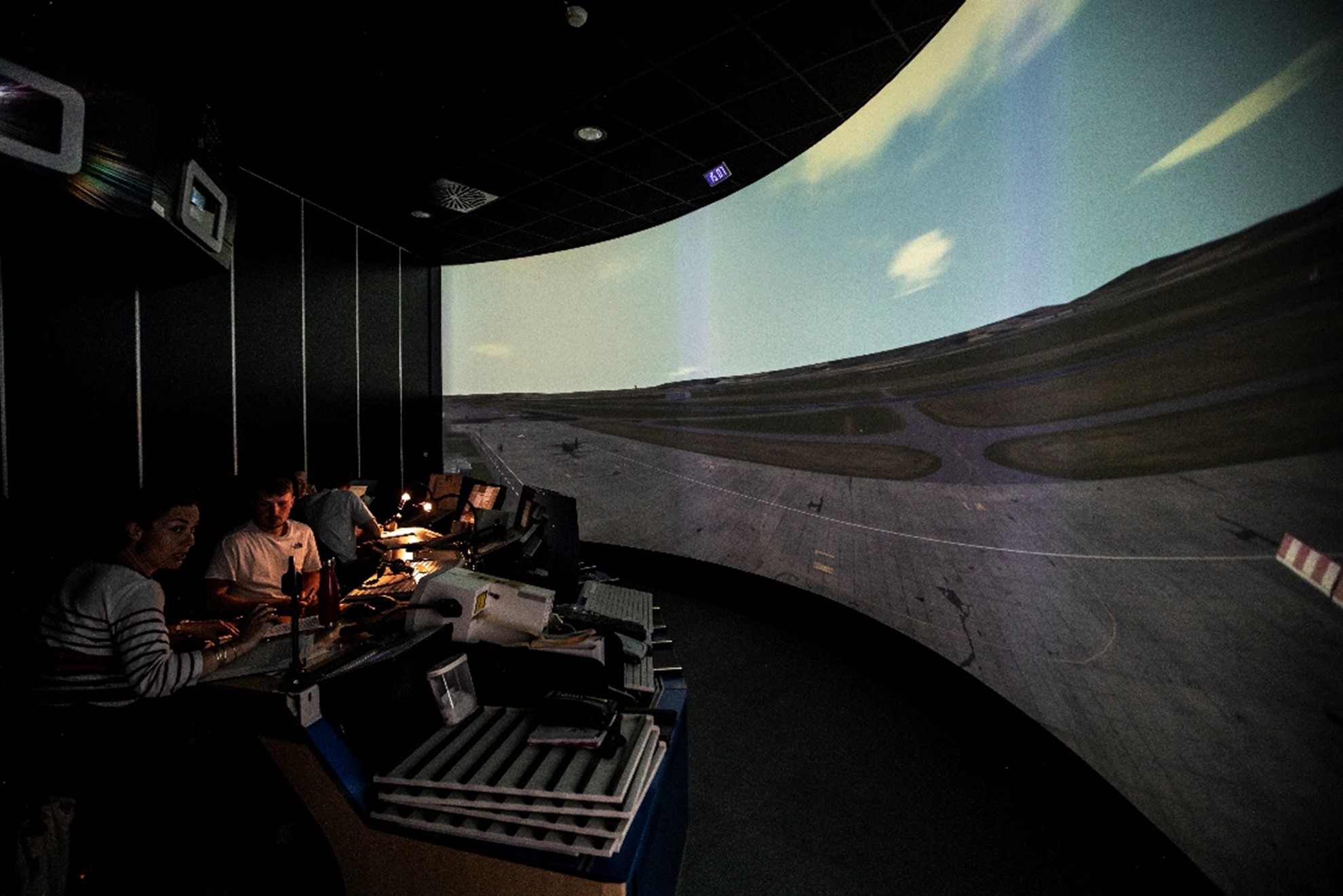
SCANTOWER is used both in Tower Control initial training for the ADI phase (ICNA , TSA, Navy, Air Force) as well as in continuing training (Transformation from En Route to Approach).
SCANBana (SCANSIM non-specific rooms) is installed in 5 stalls each includes 3 positions (2 students and 1 instructor). Viewing is done in 3D on three 50-inch screens. The rooms are said to be non- specific because they can be used for both Tower control simulation as well as for non-radar approach control simulation.
Training provided:
- Initial training: BasicTWR phase for ICNA, TSA, and the Defense.
- Continuing training: Examiners’ Training for TSA airfields, Instruction in non-routine situations.
- Introduction to Tower Control for ENAC Engineers and certain Masters programs
SCANRAD is set up in 2 rooms which has 4 positions and in 1 room which has 2 positions. Each position is designed for an executive controller and a planner. SCANRAD is intended for phases of Approach control. Radar viewing is done through IRMA which is the operational system found in French approach centers. The simulators can be coupled up with AMAN/DMAN which offers the Controller, in real time, sequencing proposals for arrivals and/or departures.
Training provided:
- Initial training: Approach for ICNA (APS 1 and APS2), and the Navy.
- Continuing training: ‘Transformation’ Training toward APP, Air Force
- Introduction to Approach Control for EPLs (Airline Pilot Trainees)
SCANRAD is also used for experimentations on air space for the benefit of other entities within the DGAC (The French Civil Aviation Authority).
En-Route Simulator with Paper Strips : ELECTRA
ELECTRA is an air traffic control simulator using paper strips conceived for the En-Route phase of control.
The DTI (Direction de la Technique et de l’Innovation (DSNA) is both the contracting authority and the contractor, assisted by subcontractors (STERIA, THALES).
It is used at ENAC for initial training of French controllers (and foreign ones) in the first two phases of En-Route: BASIC ACC.
It is also used in continuing training (Transformation from Tower/Approach to En-Route, Non-routine Situations...) and for airspace experimentations. Our system consists of 8 radar positions which can each receive an executive controller and a planner, and can be linked up to simulate several coordinated control sectors (total capacity: 250 aircraft).
En-Route Simulator in an Electronic Environment (Stripless): ESCAPE
ESCAPE is an air traffic control simulator operating in a full electronic environment, without paper strips, now conceived for the En-Route phase of control.
It is developed by Eurocontrol Bretigny.
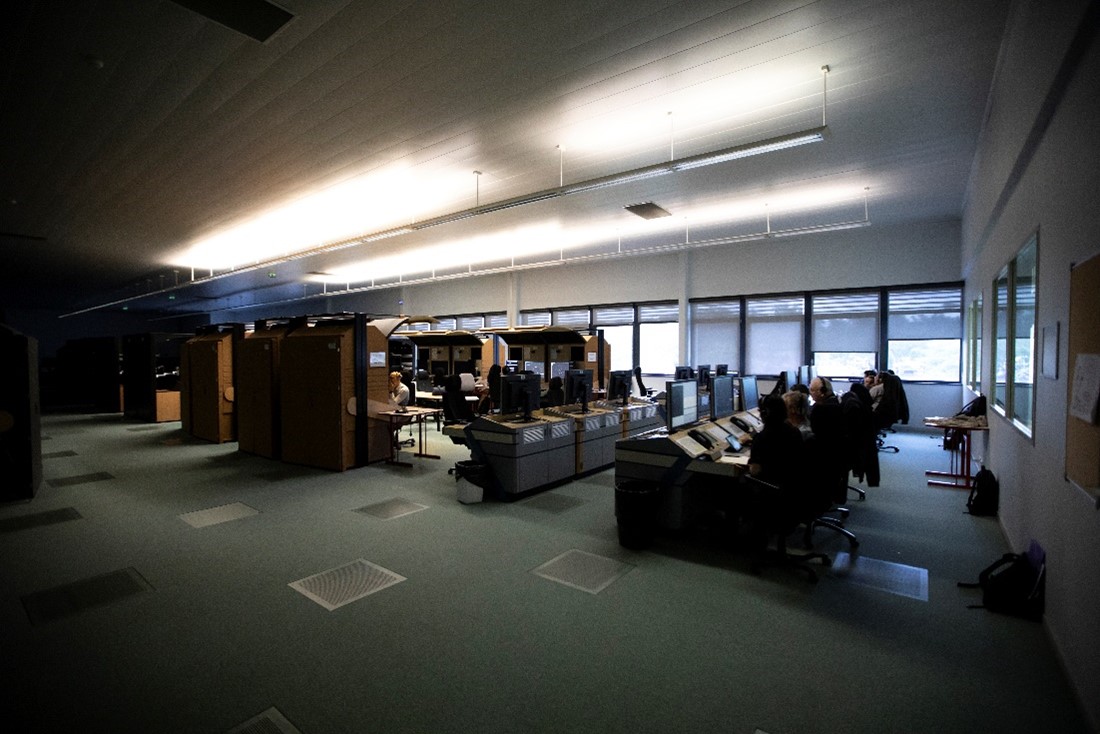
ESCAPE is used at ENAC for the second part of the ACS rating for initial training of French controllers, but also for the training of foreign controllers. It is a flexible real-time simulator that can handle:
- Up to 600 simultaneous aircraft
- Up to 1 000 flight plans
- From 1 to 64 control working positions
- From 1 to 50 pseudo-pilot positions
Voice Communication System Simulator
AudioLAN is a simulation software for radio equipment and telephone , more generally known as Voice Communication System (VCS). Developed by Eurocontrol and ENAC, it is commercialized by INEO.
It is used on all air traffic simulation positions at ENAC. It emulates, on one hand, the system that allows establishing telephone communication between different control sites, and, on the other hand, another system that allows to communicate by radio with aircraft. The air traffic controller’s VCS HMI is recreated with a high level of fidelity and equipped with telephone receiver, headsets, and foot pedal used routinely in real operations.
